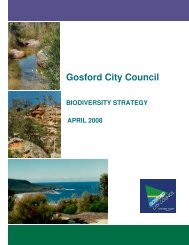Cockrone Lagoon Aquatic Biological Survey-Final Report (PDF File ...
Cockrone Lagoon Aquatic Biological Survey-Final Report (PDF File ...
Cockrone Lagoon Aquatic Biological Survey-Final Report (PDF File ...
You also want an ePaper? Increase the reach of your titles
YUMPU automatically turns print PDFs into web optimized ePapers that Google loves.
Australian <strong>Aquatic</strong> <strong>Biological</strong> Pty Ltd<br />
rectangular rake with 600 mm x 200 mm opening. Large – 600 mm x 700 mm scoop net.<br />
• Cast Net. 3m diameter cast net.<br />
• Structure removal and probing. Crayfish & molluscs shelter under rocks and logs, etc. and time<br />
was allocated to lifting such shelter objects and searching by hand for fauna. This is another<br />
particularly important method to detect species that do not respond to traps or nets.<br />
• Burrow excavation by hand. Most crayfish species construct burrows, thus an integral part<br />
of the survey involved careful excavation of burrows by hand to search for crayfish. This is a<br />
particularly important method to detect species that do not respond to traps or nets.<br />
Most animals were examined at the collection site and released after identification. Some voucher<br />
material was retained where appropriate and all retained specimens were placed in transport<br />
containers with a small amount of water and some vegetation from the site and returned to the<br />
laboratory. Selected specimens were placed in glass aquaria and photographed. Crustacean<br />
specimens were then euthanized by freezing for at least 24 hours and subsequently stored in clear,<br />
labelled specimen jars containing 70% ethanol. Tissue samples were retained in cell lysis buffer<br />
from selected specimens for subsequent DNA analysis, as part of the broader ACP.<br />
These simple methods were used to find and capture freshwater aquatic animals for identification<br />
in the <strong>Cockrone</strong> <strong>Lagoon</strong> Catchment & surrounding area. However, AABio employs a code of<br />
practice that is designed to limit the transfer of any pests and diseases from one catchment to<br />
another. For each catchment separate traps and nets are utilized and boots, etc. of field workers are<br />
sterilized between catchments.<br />
Use of traps in eastern drainages is prohibited under the Fisheries Management Act and all methods<br />
and collection was authorized under special scientific collection permits. All collections were<br />
authorized by the NSW Department of Industry and Investment under Scientific Collection Permit<br />
P05/0077-4.1. All collections were authorized by the National Parks and Wildlife Service, under<br />
Scientific Licence S13112.<br />
Figure 3. <strong>Cockrone</strong> <strong>Lagoon</strong><br />
<strong>Cockrone</strong> <strong>Lagoon</strong> Catchment <strong>Aquatic</strong> Biodiversity <strong>Report</strong> 9

















